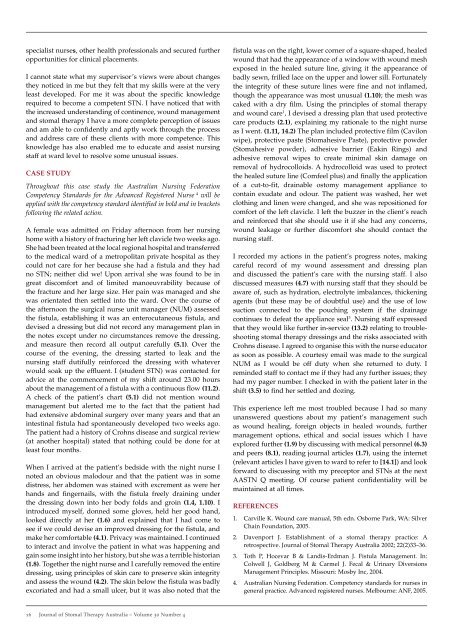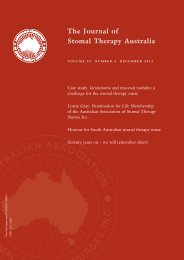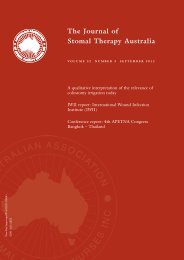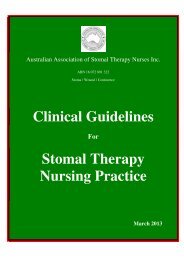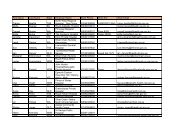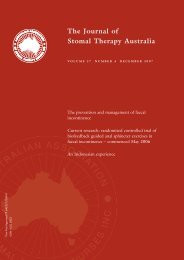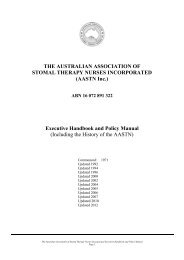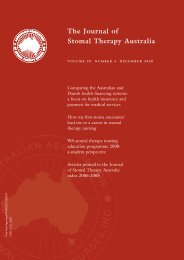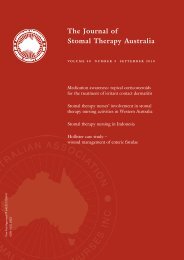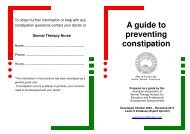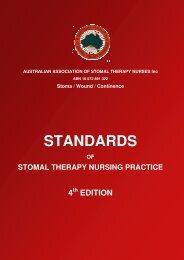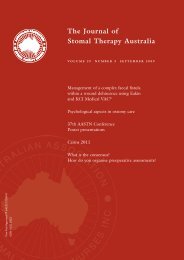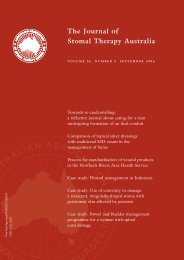JSTA December 2010 - Australian Association of Stomal Therapy ...
JSTA December 2010 - Australian Association of Stomal Therapy ...
JSTA December 2010 - Australian Association of Stomal Therapy ...
You also want an ePaper? Increase the reach of your titles
YUMPU automatically turns print PDFs into web optimized ePapers that Google loves.
specialist nurses, other health pr<strong>of</strong>essionals and secured further<br />
opportunities for clinical placements.<br />
I cannot state what my supervisor’s views were about changes<br />
they noticed in me but they felt that my skills were at the very<br />
least developed. For me it was about the specific knowledge<br />
required to become a competent STN. I have noticed that with<br />
the increased understanding <strong>of</strong> continence, wound management<br />
and stomal therapy I have a more complete perception <strong>of</strong> issues<br />
and am able to confidently and aptly work through the process<br />
and address care <strong>of</strong> these clients with more competence. This<br />
knowledge has also enabled me to educate and assist nursing<br />
staff at ward level to resolve some unusual issues.<br />
cASe STudy<br />
Throughout this case study the <strong>Australian</strong> Nursing Federation<br />
Competency Standards for the Advanced Registered Nurse 4 will be<br />
applied with the competency standard identified in bold and in brackets<br />
following the related action.<br />
A female was admitted on Friday afternoon from her nursing<br />
home with a history <strong>of</strong> fracturing her left clavicle two weeks ago.<br />
She had been treated at the local regional hospital and transferred<br />
to the medical ward <strong>of</strong> a metropolitan private hospital as they<br />
could not care for her because she had a fistula and they had<br />
no STN; neither did we! Upon arrival she was found to be in<br />
great discomfort and <strong>of</strong> limited manoeuvrability because <strong>of</strong><br />
the fracture and her large size. Her pain was managed and she<br />
was orientated then settled into the ward. Over the course <strong>of</strong><br />
the afternoon the surgical nurse unit manager (NUM) assessed<br />
the fistula, establishing it was an enterocutaneous fistula, and<br />
devised a dressing but did not record any management plan in<br />
the notes except under no circumstances remove the dressing,<br />
and measure then record all output carefully (5.1). Over the<br />
course <strong>of</strong> the evening, the dressing started to leak and the<br />
nursing staff dutifully reinforced the dressing with whatever<br />
would soak up the effluent. I (student STN) was contacted for<br />
advice at the commencement <strong>of</strong> my shift around 23.00 hours<br />
about the management <strong>of</strong> a fistula with a continuous flow (11.2).<br />
A check <strong>of</strong> the patient’s chart (5.1) did not mention wound<br />
management but alerted me to the fact that the patient had<br />
had extensive abdominal surgery over many years and that an<br />
intestinal fistula had spontaneously developed two weeks ago.<br />
The patient had a history <strong>of</strong> Crohns disease and surgical review<br />
(at another hospital) stated that nothing could be done for at<br />
least four months.<br />
When I arrived at the patient’s bedside with the night nurse I<br />
noted an obvious malodour and that the patient was in some<br />
distress, her abdomen was stained with excrement as were her<br />
hands and fingernails, with the fistula freely draining under<br />
the dressing down into her body folds and groin (1.4, 1.10). I<br />
introduced myself, donned some gloves, held her good hand,<br />
looked directly at her (1.6) and explained that I had come to<br />
see if we could devise an improved dressing for the fistula, and<br />
make her comfortable (4.1). Privacy was maintained. I continued<br />
to interact and involve the patient in what was happening and<br />
gain some insight into her history, but she was a terrible historian<br />
(1.8). Together the night nurse and I carefully removed the entire<br />
dressing, using principles <strong>of</strong> skin care to preserve skin integrity<br />
and assess the wound (4.2). The skin below the fistula was badly<br />
excoriated and had a small ulcer, but it was also noted that the<br />
16 Journal <strong>of</strong> <strong>Stomal</strong> therapy australia – Volume 30 Number 4<br />
fistula was on the right, lower corner <strong>of</strong> a square-shaped, healed<br />
wound that had the appearance <strong>of</strong> a window with wound mesh<br />
exposed in the healed suture line, giving it the appearance <strong>of</strong><br />
badly sewn, frilled lace on the upper and lower sill. Fortunately<br />
the integrity <strong>of</strong> these suture lines were fine and not inflamed,<br />
though the appearance was most unusual (1.10); the mesh was<br />
caked with a dry film. Using the principles <strong>of</strong> stomal therapy<br />
and wound care 1 , I devised a dressing plan that used protective<br />
care products (2.1), explaining my rationale to the night nurse<br />
as I went. (1.11, 14.2) The plan included protective film (Cavilon<br />
wipe), protective paste (Stomahesive Paste), protective powder<br />
(Stomahesive powder), adhesive barrier (Eakin Rings) and<br />
adhesive removal wipes to create minimal skin damage on<br />
removal <strong>of</strong> hydrocolloids. A hydrocolloid was used to protect<br />
the healed suture line (Comfeel plus) and finally the application<br />
<strong>of</strong> a cut-to-fit, drainable ostomy management appliance to<br />
contain exudate and odour. The patient was washed, her wet<br />
clothing and linen were changed, and she was repositioned for<br />
comfort <strong>of</strong> the left clavicle. I left the buzzer in the client’s reach<br />
and reinforced that she should use it if she had any concerns,<br />
wound leakage or further discomfort she should contact the<br />
nursing staff.<br />
I recorded my actions in the patient’s progress notes, making<br />
careful record <strong>of</strong> my wound assessment and dressing plan<br />
and discussed the patient’s care with the nursing staff. I also<br />
discussed measures (4.7) with nursing staff that they should be<br />
aware <strong>of</strong>, such as hydration, electrolyte imbalances, thickening<br />
agents (but these may be <strong>of</strong> doubtful use) and the use <strong>of</strong> low<br />
suction connected to the pouching system if the drainage<br />
continues to defeat the appliance seal 3 . Nursing staff expressed<br />
that they would like further in-service (13.2) relating to troubleshooting<br />
stomal therapy dressings and the risks associated with<br />
Crohns disease. I agreed to organise this with the nurse educator<br />
as soon as possible. A courtesy email was made to the surgical<br />
NUM as I would be <strong>of</strong>f duty when she returned to duty. I<br />
reminded staff to contact me if they had any further issues; they<br />
had my pager number. I checked in with the patient later in the<br />
shift (3.5) to find her settled and dozing.<br />
This experience left me most troubled because I had so many<br />
unanswered questions about my patient’s management such<br />
as wound healing, foreign objects in healed wounds, further<br />
management options, ethical and social issues which I have<br />
explored further (1.9) by discussing with medical personnel (6.3)<br />
and peers (8.1), reading journal articles (1.7), using the internet<br />
(relevant articles I have given to ward to refer to [14.1]) and look<br />
forward to discussing with my preceptor and STNs at the next<br />
AASTN Q meeting. Of course patient confidentiality will be<br />
maintained at all times.<br />
refereNceS<br />
1. Carville K. Wound care manual, 5th edn. Osborne Park, WA: Silver<br />
Chain Foundation, 2005.<br />
2. Davenport J. Establishment <strong>of</strong> a stomal therapy practice: A<br />
retrospective. Journal <strong>of</strong> <strong>Stomal</strong> <strong>Therapy</strong> Australia 2002; 22(2)33–36.<br />
3. Toth P, Hocevar B & Landis-Erdman J. Fistula Management. In:<br />
Colwell J, Goldberg M & Carmel J. Fecal & Urinary Diversions<br />
Management Principles. Missouri: Mosby Inc, 2004.<br />
4. <strong>Australian</strong> Nursing Federation. Competency standards for nurses in<br />
general practice. Advanced registered nurses. Melbourne: ANF, 2005.


